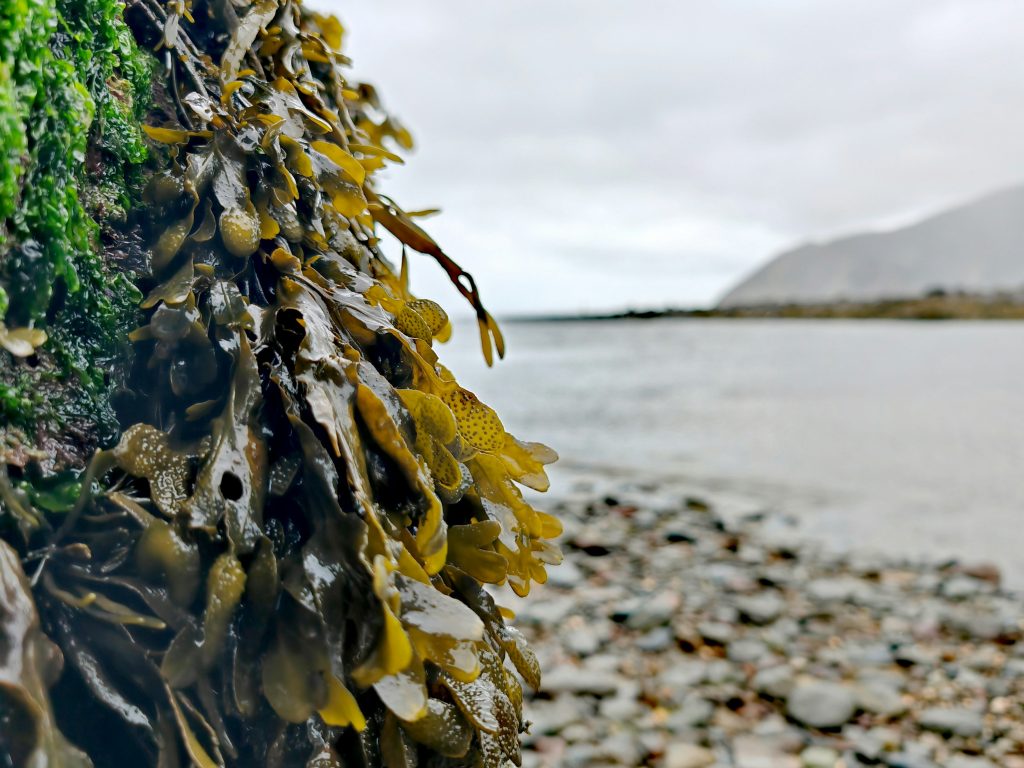Seawater and seaweed baths, known as thalassotherapy, are famous for their therapeutic benefits, and have long been popular in Ireland. Greek and Roman records from the first century BC mention herbal medicines and cosmetic preparations made with seaweed. Modern preparations include soaps, lotions, shampoos, conditioners, shower gels and even packets of powdered seaweed that can be mixed in bathwater to create home thalasso-treatments.
More importantly, seaweeds have been an important food source for thousands of years as indicated by the Chinese writer Chi Han who noted their importance in 300 BC. China is now the world’s largest producer of mixed purpose seaweeds with an annual crop of 2.5 million tons, and Japan nets nearly $1 billion on its harvest of nori which is used extensively in sushi preparation.
More than five hundred varieties of seaweed can be found in Ireland’s pristine waters, especially along the indented western shore where mild temperatures, good wave action, and a varied rocky substrata provide an excellent growth environment. Most harvesting occurs in the Gaeltacht regions of Counties Galway, Mayo and Donegal. In 1994, the crop weighed in at 34,600 tons, securing Ireland’s position as one of the world’s important seaweed producers.
During the Great Famine of 1845- ’50, fortunate coastal dwellers supplemented their meager diets with a variety of seaweeds which are rich in iodine, magnesium, calcium, potassium and many vital trace minerals. Several types of seaweed have long been important Irish dietary components.
Dulse, a reddish-brown seaweed unique to North Atlantic and Pacific Northwest waters, is found all around the Irish coast and has been eaten since the 12th century when the Hymn of Columba recorded dulse picking as one of a monk’s daily chores. “A while gathering dulse from the rock, a while fishing, a while giving food to the poor, a while in my cell.” It is often eaten plain or served as an accompaniment to bowls of steamed mussels. Dulse and yellowman (a bright yellow toffee) are traditional snacks sold at the annual Lammas Fair in Ballycastle, County Antrim.
Customarily given by a boy to his sweetheart, they appear in the song lyric “Did you treat your Mary Anne to dulse and yallaman at the auld Lammas Fair, oh!”
Carrageen, also called Irish Moss, grows in clusters of purple-brown fan shapes. It is found on stones and rocks all along the Atlantic coast, and although it can be used fresh, most people prefer using product that has been bleached and dried by rain and sun. When reconstituted in water, Carrageen releases a gelatinous substance that makes an excellent thickener in soups, drinks, jellies and milk puddings.
The plain gel is also a tried-and-true home remedy for soothing the inflamed membranes of mouth and throat when irritated by a cold or flu. Sloke is also known as sea spinach or laver. It has thin, translucent purple-green fronds and can be found on rocks and stones up and down the beaches all around the Irish coast. After being washed, soaked and simmered for several hours, it is traditionally served as a vegetable with fish or ham.
Sea-kale and samphire are two delicate seaweeds which both taste somewhat like asparagus. Unfortunately neither can be dried and you will have to travel to Ireland to experience their exotic flavor. Sea-kale, known as strand-cabbage, can be found growing wild on the sandy beaches of Donegal and in select green grocers. Samphire grows in muddy salt marshes particularly on the east coast and when picked young is tender enough to be eaten raw.
Seaweeds have been used to cure what ails, within and without, since ancient times, but this is the information age and like so many other things even these venerable gifts of the sea have gone high-tech. Further information on Ireland’s seaweeds can be found on the internet at this link here, courtesy of Chris Hession, who runs the Irish Seaweed Industry Organization, and Michael Guiry, professor of marine botany at University College Galway.
Adventurous cooks can order additional recipes, a tasty snack called Sea Chips and a selection of seaweeds including dulse and laver from: Maine Coast Sea Vegetables, Franklin, ME 04634, telephone: 207-565-2907. Slainte!
Recipes
Mussel, Dulse & Rice Broth
48 mussels, rinsed and beards removed
1 cup of white wine
1 cup water
1 ounce dried dulse, washed and shredded
1 cup cooked rice
1 tablespoon chopped fresh dill
2 tablespoons grated parmesan cheese
Place mussels in a large stockpot with wine and water. Cook over medium heat until all the mussels have opened. Remove mussels and shell, and set meat aside. Discard the shells.
Strain stock into a clean saucepan. Add rice and dulse. Bring to a boil, then reduce heat to simmer and cook until dulse is tender, about 10 minutes. Add mussels and stir in chopped dill. Spoon into large bowls and sprinkle on grated parmesan. Makes 4 servings.
– Gerry Galvin, Chef, Drimcong House, Moycullen, County Galway.
Carrageen Jelly
1/2 ounce carrageen
1 pint water
2 teaspoons lemon juice
sugar to taste
small wine glass of sweet sherry
whipped cream
Soak the carrageen in water for a few hours, then rinse well and drain.
Put in a pan with 1 pint of water and simmer for about 20 minutes. Strain and discard the carrageen. Add the sugar, lemon juice, and sherry to the strained liquid and stir. Pour into 4 small heatproof dishes and refrigerate until set. Serve with whipped cream. Makes 4 servings.
Traditional Irish Food – Theodora Fitzgibbon
Editor’s Note: This article was originally published in the January / February 1998 issue of Irish America. ⬥


Leave a Reply